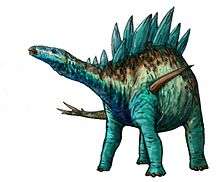Hylaeosaurus
| Hylaeosaurus Temporal range: Early Cretaceous, 140–136 Ma | |
|---|---|
 | |
| Holotype NMH R3775 | |
| Scientific classification | |
| Kingdom: | Animalia |
| Phylum: | Chordata |
| Class: | Reptilia |
| Clade: | Dinosauria |
| Order: | †Ornithischia |
| Suborder: | †Ankylosauria |
| Family: | †Nodosauridae |
| Genus: | †Hylaeosaurus Mantell, 1833 |
| Species: | †H. armatus |
| Binomial name | |
| Hylaeosaurus armatus Mantell, 1833 | |
| Synonyms | |
| |
Hylaeosaurus (/haɪˌliːoʊˈsɔːrəs/ hy-LEE-o-SAWR-rəs; Greek: hylaios/ὑλαῖος "belonging to the forest" and sauros/σαυρος "lizard") is a herbivorous ankylosaurian dinosaur that lived about 136 million years ago, in the late Valanginian stage of the early Cretaceous period of England.
Hylaeosaurus was one of the first dinosaurs to be discovered, in 1832 by Gideon Mantell. In 1842 it was one of the three dinosaurs Richard Owen based the Dinosauria on. Four species were named in the genus, but only the type species Hylaeosaurus armatus is today considered valid. Only limited remains have been found of Hylaeosaurus and much of its anatomy is unknown. It might have been a basal nodosaurid, although a recent cladistic analysis recovers it as a basal ankylosaurid.[1]
Hylaeosaurus was about five metres long. It was an armoured dinosaur. It carried at least three long spines on its shoulder and shorter spines at the side of its neck.
History of discovery

The first Hylaeosaurus fossils were discovered in West Sussex. On 20 July 1832, fossil collector Gideon Mantell wrote to Professor Benjamin Silliman that when a gunpowder explosion had demolished a quarry rock face in Tilgate Forest, several of the boulders freed showed the bones of a saurian. A local fossil dealer had assembled the about fifty pieces, described by him as a "great consarn of bites and boanes". Having doubts about the value of the fragments, Mantell had nevertheless purchased the pieces and soon discovered they could be united into a single skeleton, partially articulated. Mantell was delighted with the find because previous specimens of Megalosaurus and Iguanodon had consisted of single bone elements. The discovery in fact represented the most complete non-avian dinosaur skeleton known at the time. He was strongly inclined to describe the find as belonging to the latter genus, but during a visit by William Clift, the curator of the Royal College of Surgeons of England museum, and his assistant John Edward Gray, he began to doubt the identification. Clift was the first to point out that several plates and spikes were probably part of a body armour, attached to the back or sides of the rump.[2] In November 1832 Mantell decided to create a new generic name: Hylaeosaurus. It is derived from the Greek ὑλαῖος, hylaios, "of the wood". Mantell originally claimed the name Hylaeosaurus meant "forest lizard", after the Tilgate Forest in which it was discovered.[3] Later, he claimed that it meant "Wealden lizard" ("wealden" being another word for forest), in reference to the Wealden Group, the name for the early Cretaceous geological formation in which the dinosaur was first found.[4]

On 30 November Mantell sent the piece to the Geological Society of London. Shortly afterwards he himself went to London and on 5 December during a meeting of the Society, in which he for the first time personally met Richard Owen, reported on the find to large acclaim. However, he was also informed that a paper he had already prepared, was a third too long. On advice of his friend Charles Lyell, Mantell decided instead of rewriting the paper, to publish an entire book on his fossil finds and dedicate a chapter to Hylaeosaurus. Within three weeks Mantell composed the volume from earlier notes. On 17 December Henry De la Beche warned him that the changed conventions in nomenclature implied that only he who provided a full species name was recognised as the author: to Hylaeosaurus a specific name needed to be added.[2] Mantell on 19 December chose armatus, Latin for "armed" or "armoured", in reference to the spikes and armour plates. As Mantell himself put it: "there appears every reason to conclude that either its back was armed with a formidable row of spines, constituting a dermal fringe, or that its tail possessed the same appendage". In May 1833 his The Geology of the South-East of England appeared, hereby validly naming the type species Hylaeosaurus armatus. Mantell published a lithograph of his find in The Geology of the South-East of England;[5] and another drawing in the fourth edition of The Wonders of Geology, in 1840.

Hylaeosaurus is the most obscure of the three animals used by Sir Richard Owen to first define the new group Dinosauria, in 1842, the other genera being Megalosaurus and Iguanodon. Not only has Hylaeosaurus received less public attention, despite being included in the life-sized models by Benjamin Waterhouse Hawkins placed in the Crystal Palace Park, it also never functioned as a "wastebasket taxon". Owen in 1840 developed a new hypothesis about the spikes; noting they were asymmetrical he correctly rejected the notion they formed a row on the back but incorrectly assumed they were gastralia or belly-ribs.
The original specimen, recovered by Gideon Mantell from the Tilgate Forest, was later acquired by the Natural History Museum of London. It has the inventory number NHMUK 3775 (earlier BMNH R3775). It was found in a layer of the Grinstead Clay Formation dating from the Valanginian, about 137 million year old. This holotype is the best specimen and is composed of the front end of a skeleton minus most of the head and the forelimbs, though only the parts on the face of the stone block are easily studied. The block measures about 135 by 75 centimetres. The holotype consists of the rear of the skull and perhaps lower jaws, ten vertebrae, both scapulae, both coracoids and several spikes and armour plates. The skeleton is viewed from below. For a long time no further preparation had taken place, beyond the assembly and chiselling out by Mantell himself, but in the early twenty-first century the museum began to further free the bones by both chemical and mechanical means.[6] The information gained hereby has not yet been published. Several finds from the mainland of Britain have been referred to Hylaeosaurus armatus.[7][8] However, in 2011 Paul Barrett and Susannah Maidment concluded that only the holotype could with certainty be associated with the species, in view of the presence of Polacanthus in the same layers.[9]
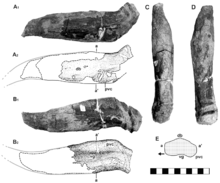
Additional remains have been referred to Hylaeosaurus, from the Isle of Wight, (the Ardennes of) France,[10] Germany,[11] Spain[12] and Romania.[13] The remains from France may actually belong to Polacanthus and the other references are today also considered dubious.[6][14] However, possible remains were reported from Germany in 2013: a spike, specimen DLM 537 and the lower end of a humerus, specimen GPMM A3D.3, which were referred to a Hylaeosaurus sp.[15]
Later species

Hylaeosaurus armatus Mantell 1833 is currently considered the only valid species in the genus. However, three others have been named. In 1844, Mantell named Hylaeosaurus oweni based on the same specimen as H. armatus, wanting to honour Richard Owen.[16] This has been sunk as a junior objective synonym of H. armatus.[7] In 1956 Alfred Romer renamed Regnosaurus into Hylaeosaurus northhamptoni.[17] Polacanthus Owen 1865 was by Walter Coombs in 1971 renamed into Hylaeosaurus foxii.[18] These last two names have found no acceptance; H. foxii remained an invalid nomen ex dissertatione. It has also been suggested that Polacanthus is simply the same species as Hylaeosaurus armatus and thus a junior synonym, but there are a number of differences in their osteology.
Sometimes bones from the Hylaeosaurus material have later been made separate species. In 1928 Franz Nopcsa made specimen BMNH 2584, a left scapula referred by Mantell to H. armatus,[19] part of the type material of Polacanthoides ponderosus.[20] Though in 1978 synonymised with Hylaeosaurus,[21] Polacanthoides is today considered a nomen dubium,[22] an indeterminate member of the Thyreophora.
Description
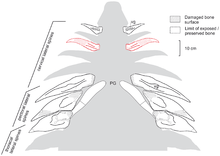
Gideon Mantell originally estimated that Hylaeosaurus was about 25 feet (7.6 m) long, or about half the size of the other two original dinosaurs, Iguanodon and Megalosaurus. At the time, he modelled the animal after a modern lizard. Modern estimates range up to 6 metres (20 ft) in length.[23] Gregory S. Paul in 2010 estimated the length at five metres, the weight at two tonnes.[24] Some estimates are considerably lower: in 2001 Darren Naish e.a. gave a length of three to four metres.[14]
Many details about the build of Hylaeosaurus are unknown, especially if the material is strictly limited to the holotype. Maidment gave two autapomorphies, unique derived traits: the scapula did not fuse with the coracoid, even when the animal was of a considerable size; there were three long spines on its shoulder.[9] Even these traits are not very distinctive: Mantell and Owen had attributed the lack of fusion to ontogeny and the total number of spines cannot be observed. Hylaeosaurus is often styled as a fairly typical nodosaur, with rows of armour plating on the back and tail combined with a relatively long head, equipped with a beak used to crop low-lying vegetation.
In 2001 the skull and lower jaws remains were described by Kenneth Carpenter. The damaged and shifted skull elements provided little information. The quadrate is laterally bowed. The quadratojugal has a high attachment point on the shaft of the quadrate. A triangular postorbital horn was present.[25]
The spines at the shoulder are curved to the rear, long, flattened, narrow and pointed. Their underside shows a shallow trough. The front spine is the longest at 42.5 centimetres; to the rear the spines become gradually shorter and wider. A fourth spine, of about the same build but more forward-pointing, is present immediately behind the skull. In 2013 Sven Sachs and Jahn Hornung suggested a configuration in which there were five lateral neck spines, the new German spine having a morphology adapted to fit in the third position.[15]
Phylogeny
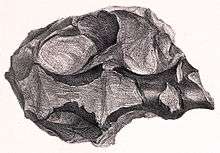
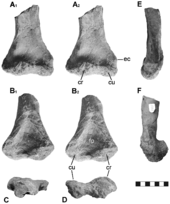
Hylaeosaurus was the first ankylosaur discovered. Until well into the twentieth century its exact affinities would remain uncertain. In 1978 Coombs assigned it to the Nodosauridae within the Ankylosauria.[21] This is still a usual classification, Hylaeosaurus being recovered as a basal nodosaurid in most exact cladistic analyses, sometimes more precisely as a member of the Polacanthinae, and thus being related to Gastonia and Polocanthus. However, in the 1990s, the polocanthines were sometimes seen as basal ankylosaurids, because they were mistakenly believed to have small tail-clubs. A more popular alternative today is that they formed a Polacanthidae, a basal group outside of the nodosaurids + ankylosaurids clade.
A 2012 study finding Hylaeosaurus to be a basal nodosaurid but not a polacanthine is shown in this cladogram:[26]
| Nodosauridae |
| |||||||||||||||||||||||||||||||||||||||||||||||||||||||||||||||||||||||||||||||||||||||||||||||||||||||||||||||
| |
See also
References
- ↑ "Ankylosaurian dinosaur palaeoenvironmental associations were influenced by extirpation, sea-level fluctuation, and geodispersal". Palaeogeography, Palaeoclimatology, Palaeoecology. 449: 289–299. doi:10.1016/j.palaeo.2016.02.033.
- 1 2 Dennis R. Dean, 1999, Gideon Mantell and the Discovery of Dinosaurs, Cambridge University Press, 315 pp
- ↑ Mantell, Gideon Algernon (1833). "Observations on the remains of the Iguanodon, and other fossil reptiles, of the strata of Tilgate Forest in Sussex". Proceedings of the geological Society of London. 1: 410–411.
- ↑ Mantell, G.A., 1838, The Wonders of Geology or a Familiar Exposition of Geological Phenomena, 2 vols, Relfe and Fletcher, London
- ↑ G.A. Mantell. 1833. The Geology of the South-East of England. Longman Ltd., London
- 1 2 Naish, D.; Martill, D.M. (2008). "Dinosaurs of Great Britain and the role of the Geological Society of London in their discovery: Ornithischia". Journal of the Geological Society, London. 165: 613–623. doi:10.1144/0016-76492007-154.
- 1 2 Pereda-Suberbiola, J (1993). "Hylaeosaurus, Polacanthus, and the systematics and stratigraphy of Wealden armoured dinosaurs". Geological Magazine. 130 (6): 767–781. doi:10.1017/s0016756800023141.
- ↑ Barrett, P.M. (1996). "The first known femur of Hylaeosaurus armatus and reidentification of ornithopod material in The Natural History Museum, London". Bulletin of the Natural History Museum (Geology). 52: 115–118.
- 1 2 Barrett, P.M. and Maidment, S.C.R., 2011, "Wealden armoured dinosaurs". In: Batten, D.J. (ed.). English Wealden fossils. Palaeontological Association, London, Field Guides to Fossils 14, 769 pp
- ↑ Corroy, G (1922). "Les reptiles néocomiens et albiens du Bassin de Paris". Comptes Rendus de l’Académie des Sciences de Paris. 172: 1192–1194.
- ↑ Koken, E (1887). "Die Dinosaurier, Crocodiliden und Sauropterygier des norddeutschen Wealden". Geologische und Palaeontologische Abhandlungen. 3: 311–420.
- ↑ Sanz, J.L. (1983). "A nodosaurid ankylosaur from the Lower Cretaceous of Salas de los Infantes (Province of Burgos, Spain)". Geobios. 16: 615–621. doi:10.1016/s0016-6995(83)80038-2.
- ↑ E. Posmosanu, 2003, "The palaeoecology of the dinosaur fauna from a Lower Cretaceous bauxite deposit from Bihor (Romania)". In: A. Petculescu & E. Stiuca (eds.), Advances in Vertebrate Paleontology: Hen to Panta. Romanian Academy, "Emil Racovita" Institute of Speleology, Bucarest pp. 121-124
- 1 2 Naish, D. and Martill, D.M., 2001, "Armoured Dinosaurs: Thyreophorans". In: Martill, D.M., Naish, D., (editors). Dinosaurs of the Isle of Wight. Palaeontological Association Field Guides to Fossils 10. pp. 147–184
- 1 2 Sachs, S.; Hornung, J. J. (2013). Evans, David C, ed. "Ankylosaur Remains from the Early Cretaceous (Valanginian) of Northwestern Germany". PLoS ONE. 8 (4): e60571. doi:10.1371/journal.pone.0060571.
- ↑ Mantell, G.A. 1844. The Medals of Creation: or first lessons in geology and in the study of organic remains. London Volume 2, pp. 587-876
- ↑ Romer, A.S. 1956. Osteology of the Reptiles. University of Chicago Press, Chicago
- ↑ Coombs, W. 1971. The Ankylosauria. Ph.D. thesis, New York: Columbia University
- ↑ Mantell, G.A. (1841). "Memoir on a portion of the lower jaw of the Iguanodon and on the remains of the Hylaeosaurus and other saurians, discovered in the strata of Tilgate Forest, in Sussex". Philosophical Transactions of the Royal Society of London. 131: 131–151. doi:10.1098/rstl.1841.0013.
- ↑ Nopcsa, F., 1928, "Palaeontological notes on Reptiles", Geologica Hungarica, Series Palaeontologica, tomus, 1, -Pasc. 1, p. 1-84
- 1 2 Coombs, W.P. (1978). "The families of the ornithischian dinosaur order Ankylosauria". Palaeontology. 21 (1): 143–170.
- ↑ Blows, W.T. (1987). "The armoured dinosaur Polacanthus foxi from the Lower Cretaceous of the Isle of Wight". Palaeontology. 30 (3): 557–580.
- ↑ Palmer, D., ed. (1999). The Marshall Illustrated Encyclopedia of Dinosaurs and Prehistoric Animals. London: Marshall Editions. p. 157. ISBN 1-84028-152-9.
- ↑ Paul, G.S., 2010, The Princeton Field Guide to Dinosaurs, Princeton University Press p. 228
- ↑ Carpenter, K., 2001, "Skull of the polacanthid ankylosaur Hylaeosaurus armatus Mantell, 1833, from the Lower Cretaceous of England", pp 169–172 In: Carpenter, K. (ed.). The armored dinosaurs. Indiana University Press, Bloomington and Indianapolis, 525 pp
- ↑ Thompson, Richard S.; Parish, Jolyon C.; Maidment, Susannah C. R.; Barrett, Paul M. (2012). "Phylogeny of the ankylosaurian dinosaurs (Ornithischia: Thyreophora)". Journal of Systematic Palaeontology. 10 (2): 301–312. doi:10.1080/14772019.2011.569091.
